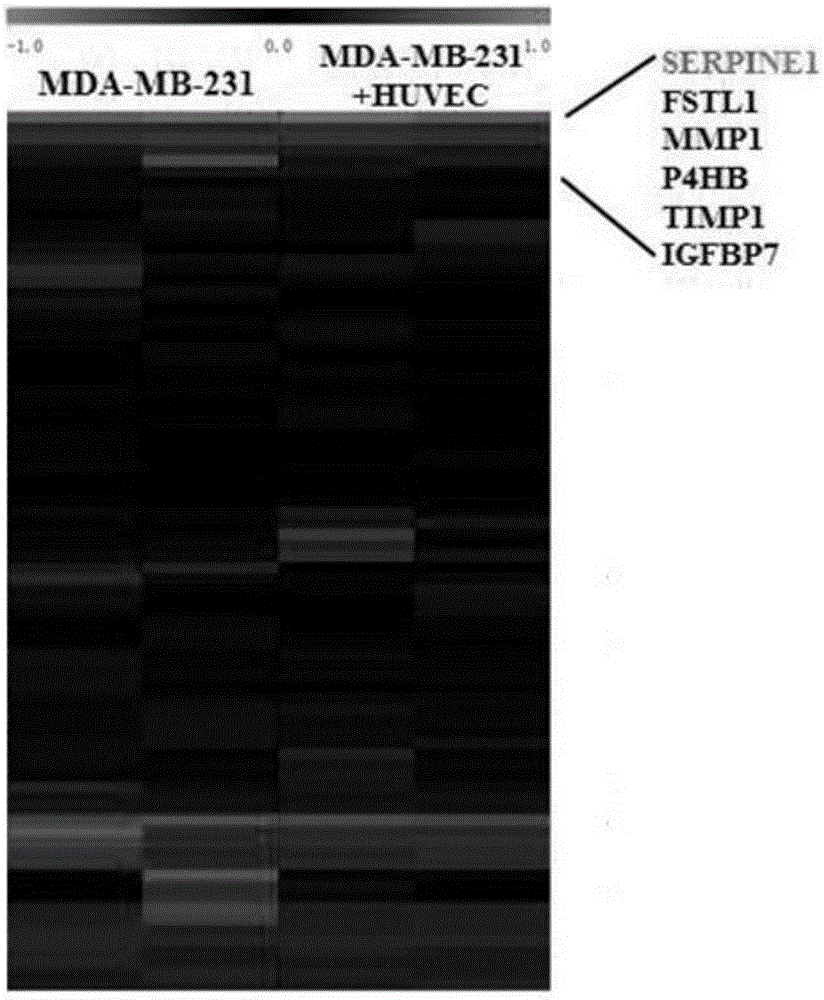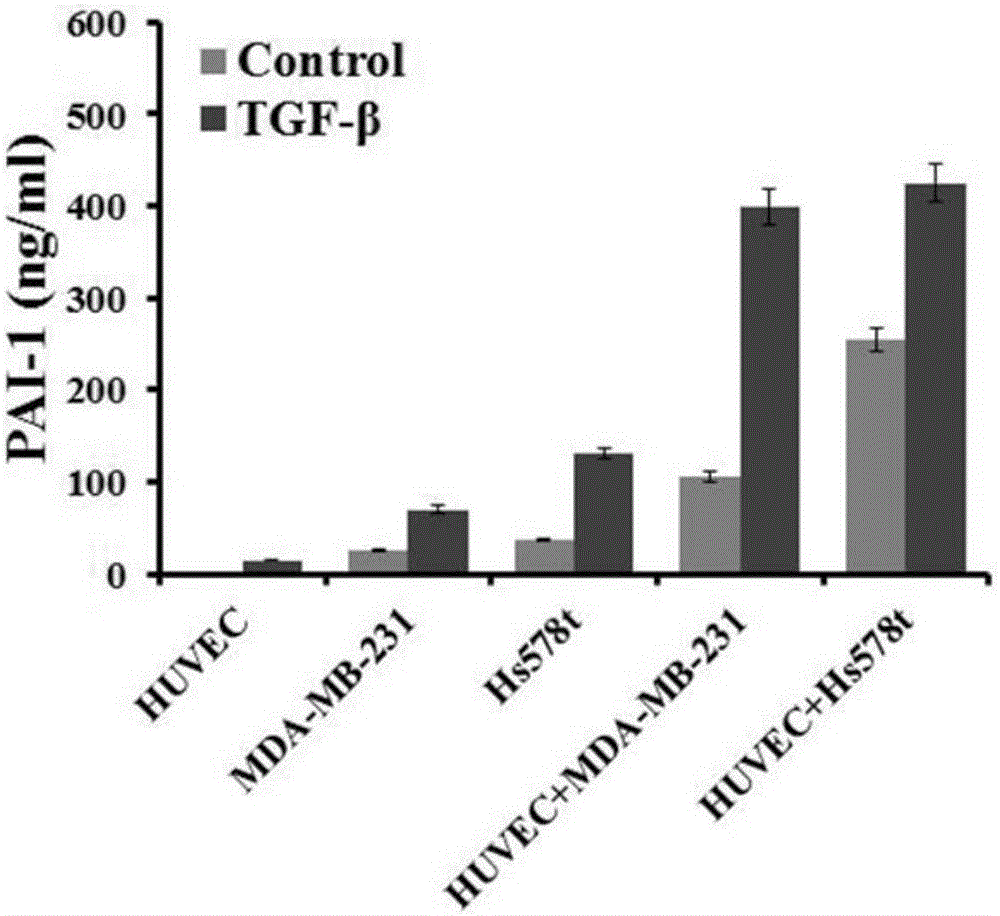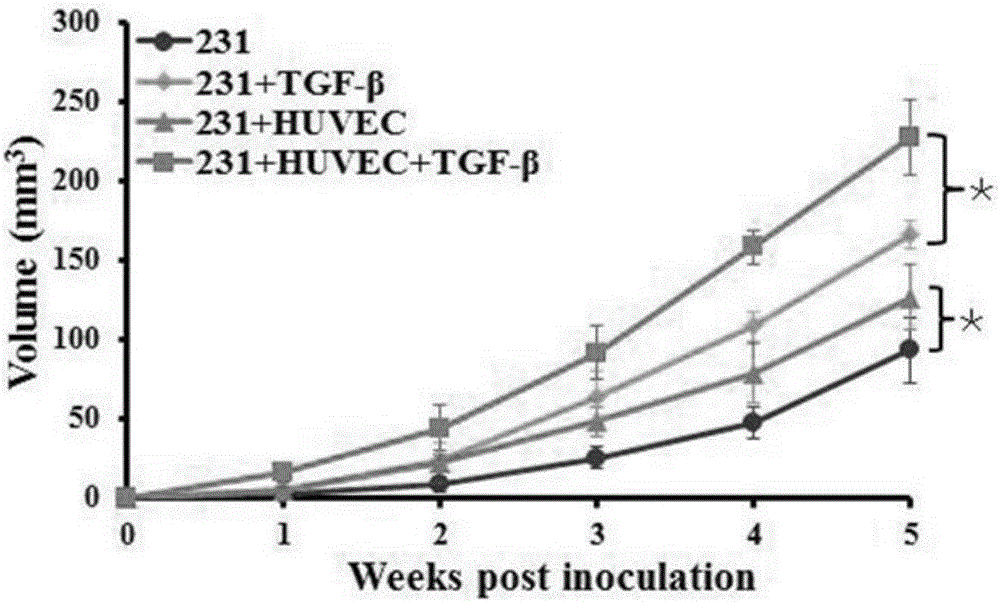Method for detecting influence of triple negative breast cancer cell on endothelial cell secretion function in epithelial-mesenchymal transition process
A technology for triple-negative breast cancer and breast cancer cells, which is used in the detection of programmed cell death, biochemical equipment and methods, and the determination/inspection of microorganisms.
- Summary
- Abstract
- Description
- Claims
- Application Information
AI Technical Summary
Problems solved by technology
Method used
Image
Examples
Embodiment 1
[0045] The triple-negative breast cancer cell line MDA-MB-231 and human umbilical vein endothelial cells HUVEC were selected, the experimental group MDA-MB-231 and HUVEC co-culture group, and the control group MDA-MB-231 cultured alone group. After being stimulated with 10ng / ml TGF-β for 36 hours, TMT quantitative proteome expression profiling was used to analyze the differential expression of secreted proteins in the cell supernatants of the two groups. It was found that the secretion of SERPINE1 (PAI-1) factor increased about 3 times in the co-culture group.
[0046] The triple-negative breast cancer cell line MDA-MB-231 was separately cultured in the cell culture dish, or the triple-negative breast cancer cell line MDA-MB-231 and human umbilical vein endothelial cells HUVEC were co-cultured in the upper and lower chambers (the upper chamber was inoculated with HUVECs). Cells, MDA-MB-231 cells were inoculated in the lower chamber), the medium was changed and 10ng / ml TGF-β wa...
Embodiment 2
[0067] Verification of expression profiling results: set up HUVEC separate culture group, triple negative breast cancer cell line MDA-MB-231 separate culture group, triple negative breast cancer cell line Hs578t separate culture group, triple negative breast cancer cell line MDA-MB-231 and HUVEC Co-culture group and triple-negative breast cancer cell line Hs578t and HUVEC co-culture group, a total of five groups. They were stimulated with 10ng / ml TGF-β for 36 hours, and ELISA technology was used to detect the changes of PAI-1 factor secretion before and after stimulation in each group.
[0068] In cell culture dishes, triple-negative breast cancer cell line MDA-MB-231, triple-negative breast cancer cell line Hs578t, human umbilical vein endothelial cells HUVEC, or triple-negative breast cancer cell line MDA-MB-231 and human umbilical cord Venous endothelial cells HUVEC were co-cultured in the upper and lower chambers (the upper chamber was inoculated with HUVEC cells, and the ...
Embodiment 3
[0079] Animal experiment verification: the triple-negative breast cancer cell line MDA-MB-231 or MDA-MB-231 and HUVEC were co-cultured and subcutaneously injected into immunodeficient mice to establish xenograft tumor models, and the mice were injected with PBS around the tumor Or TGF-β, the size of the transplanted tumor was measured regularly; the mice were euthanized 5 weeks after tumor formation, and the body weight of the mice in each group was measured. Venous blood was drawn from mice at the 3rd and 5th week of tumor formation, and the concentrations of PAI-1 and TGF-β were detected by ELISA. Immunohistochemistry for PAI-1, EMT-related indicators E-Cadherin, N-Cadherin and proliferation index Ki-67 was performed on tumor tissues of mice in each group.
[0080] Collect MDA-MB-231 cells cultured in 1640 medium containing 10% imported fetal bovine serum, 1% 100U / ml penicillin-100mg / L streptomycin, or co-culture MDA-MB-231 and HUVEC (1:1) For cells, when the cells are cult...
PUM
 Login to View More
Login to View More Abstract
Description
Claims
Application Information
 Login to View More
Login to View More - R&D
- Intellectual Property
- Life Sciences
- Materials
- Tech Scout
- Unparalleled Data Quality
- Higher Quality Content
- 60% Fewer Hallucinations
Browse by: Latest US Patents, China's latest patents, Technical Efficacy Thesaurus, Application Domain, Technology Topic, Popular Technical Reports.
© 2025 PatSnap. All rights reserved.Legal|Privacy policy|Modern Slavery Act Transparency Statement|Sitemap|About US| Contact US: help@patsnap.com



